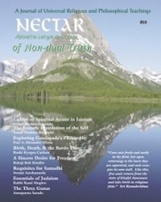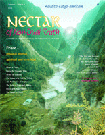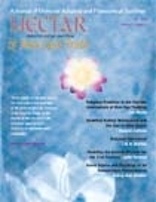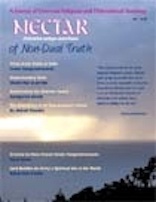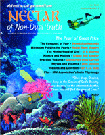10 Essence of Advaita Vedanta, Part 2
by Alexander Hixon
In this second installment of three, more of the deep nondual elements of Gaudapada’s commentary on the Mandukyopanisad are revealed for contemplation.
16 Ladder of Spiritual Ascent in Jainism
by Swami Brahmeshananda
This is the ninth in an ongoing series of articles on the Jain religion, gleaned from the first hand experi- ence of this swami of the Ramakrishna Order who lived and learned among the Jains while on pilgrimage to their holy sites and temples.
20 The Gunas in Vedic Cosmology
by Annapurna Sarada
The teaching of the three gunas of Prakriti, unique in all the philosophies of the world, bears repeating many times in order that it sink into the human mind on a primal level, revealing the need to transcend all three and break free of the bondage of cycles they sustain.
27 Mumukshutvam – Desire for Freedom
by Babaji Bob Kindler
In Vedanta, one gains the pure desire for Liberation from rock solid faith. This faith springs from the abili- ty to concentrate the mind on Reality, which in turn proceeds from qualities such as forbearance, content- ment, inner peace, and self control. All of these are based in the ability to discriminate between what is essential and nonessential, followed by the successful move to detach from the nonessential at will.
32 Essentials of Judaism
by Rabbi Rami Shapiro
In a tour-de-force expose of the many facets of Judaism, the mainstays of a Jewish man’s and woman’s spiritual life and practice come to light, guiding the contemporary votary to a clear understanding of this ancient pathway to Enlightenment.
|
38 The Ecstatic Dissolution of the Self
by Anam Thubten Rinpoche
The marked difference, in both capacity and clarity of awareness, between the human ego and what realized souls speak of as Witness Consciousness, is well docu- mented in this engaging article, transmitted from the enlightened perspective of Tibetan Buddhism by one of its dedicated Rinpoches. The entire premise of the teachings centers around gaining the ability in prac- tice to gently let go of all egoic superimpositions in order to alleviate fear and embrace subtle joy within.
42 Requisites to Samadhi
by Swami Aseshananda
This is the ninth transcription of the many discourses of Swami Aseshananda that the Nectar staff has ren- dered for the written page, in service of the spiritual practitioner of Vedanta, as well as any lover of Truth and Philosophy. In this offering, the revered swami astutely lays out the necessary qualifications that a sin- cere aspirant will have to meet in order to place the soul in the superlative position for the rarest of all spiritual experiences — Samadhi.
47 Birth, Death, and the Bardo Plane
by Abbot Kyogen Carlson
Abbot Kyogen Carlson, Godo of the Dharma Rain Zendo in Portland, Oregon, departed the body in September of 2014. Prior to his demise he gave this talk on a subject that is seldom taken up in any depth in the Zen tradition, that of the Bardo state and its various planes. Necessarily — and poignantly, consid- ering his own passing — this topic bridges on the inscrutable areas of human birth and death, a teaching that is extremely important to all schools of Buddhism.
|

